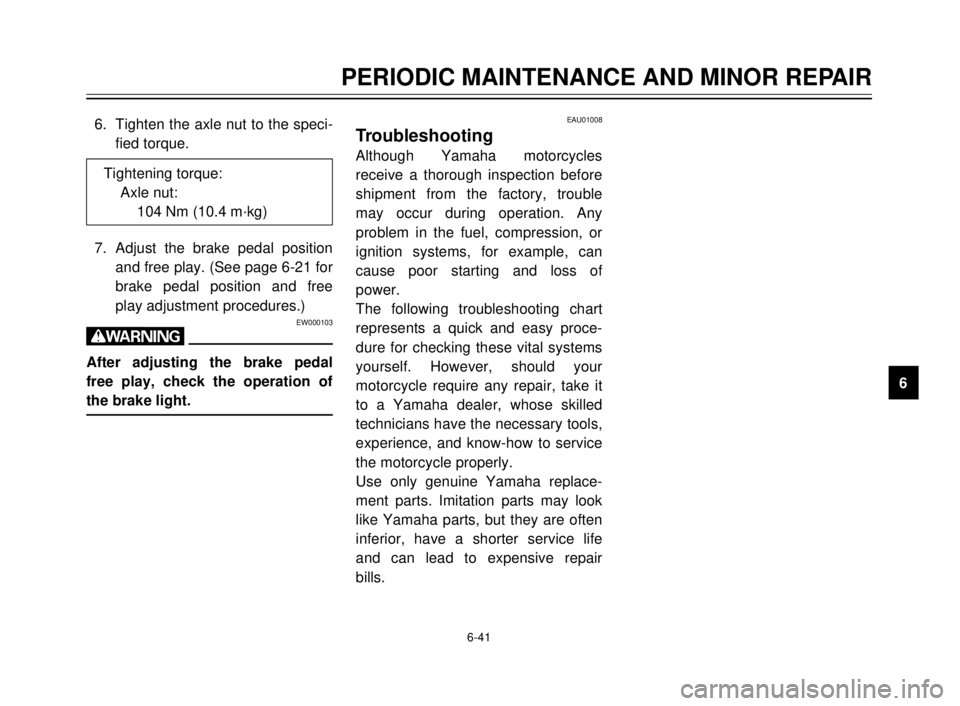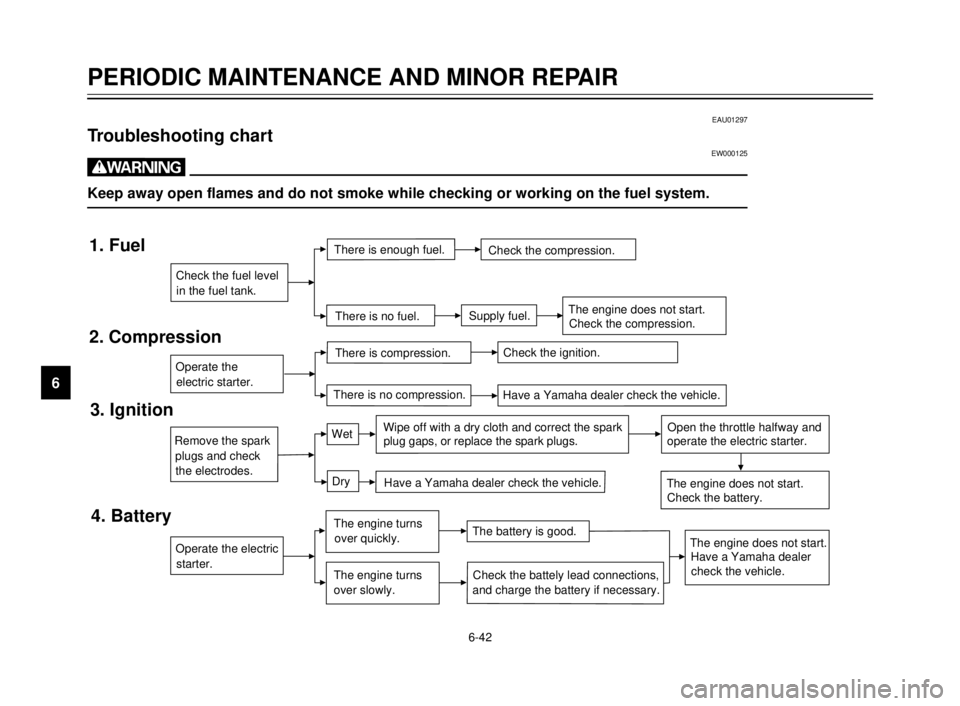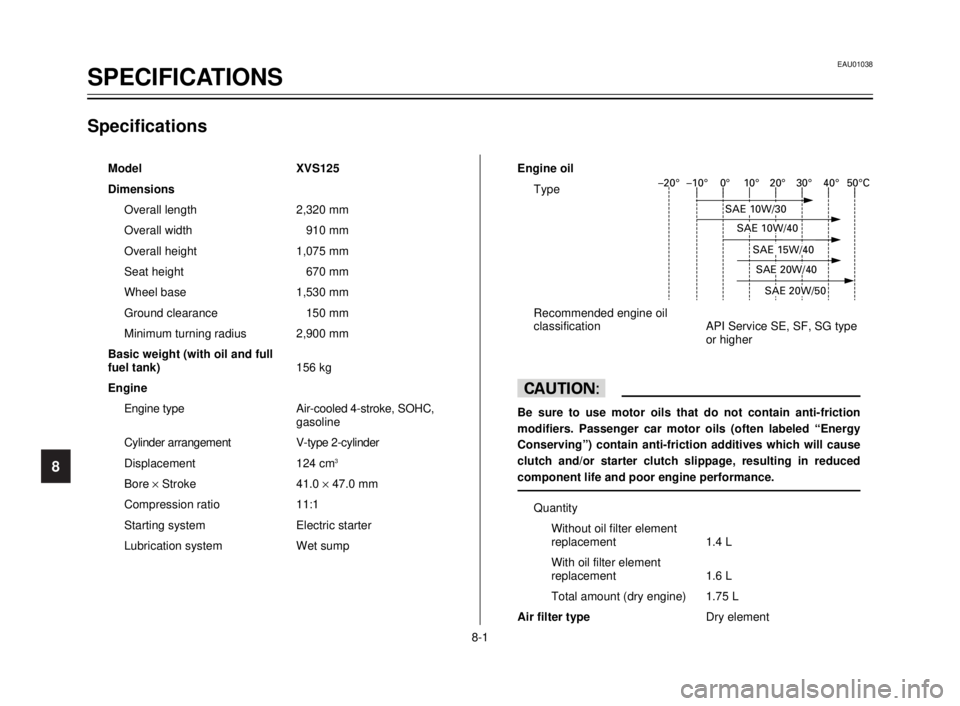YAMAHA XVS125 2000 Manual PDF
Manufacturer: YAMAHA, Model Year: 2000, Model line: XVS125, Model: YAMAHA XVS125 2000Pages: 86, PDF Size: 3.07 MB
Page 71 of 86

1
2
3
4
5
6
7
8
9
6-41
PERIODIC MAINTENANCE AND MINOR REPAIR
6. Tighten the axle nut to the speci-
fied torque.
7. Adjust the brake pedal position
and free play. (See page 6-21 for
brake pedal position and free
play adjustment procedures.)
EW000103
w
After adjusting the brake pedal
free play, check the operation of
the brake light.
EAU01008
Troubleshooting
Although Yamaha motorcycles
receive a thorough inspection before
shipment from the factory, trouble
may occur during operation. Any
problem in the fuel, compression, or
ignition systems, for example, can
cause poor starting and loss of
power.
The following troubleshooting chart
represents a quick and easy proce-
dure for checking these vital systems
yourself. However, should your
motorcycle require any repair, take it
to a Yamaha dealer, whose skilled
technicians have the necessary tools,
experience, and know-how to service
the motorcycle properly.
Use only genuine Yamaha replace-
ment parts. Imitation parts may look
like Yamaha parts, but they are often
inferior, have a shorter service life
and can lead to expensive repair
bills. Tightening torque:
Axle nut:
104 Nm (10.4 m·kg)
5JX-9-E0 4/9/0 4:11 AM Page 69
Page 72 of 86

6-42
1
2
3
4
5
6
7
8
9
PERIODIC MAINTENANCE AND MINOR REPAIR
EAU01297
Troubleshooting chartEW000125
w
Keep away open flames and do not smoke while checking or working on the fuel system.
1. Fuel
2. Compression
3. Ignition
4. Battery
Remove the spark
There is compression.
There is no compression.Check the ignition.
Have a Yamaha dealer check the vehicle.
Wet
DryWipe off with a dry cloth and correct the spark
Have a Yamaha dealer check the vehicle.
The engine turns
The engine turnsThe battery is good.
Check the battely lead connections,
Check the fuel level
There is enough fuel.
There is no fuel.Check the compression.
in the fuel tank.
the electrodes. plugs and check
over quickly.
over slowly. and charge the battery if necessary.Open the throttle halfway and
The engine does not start.Check the battery.operate the electric starter. plug gaps, or replace the spark plugs.
Supply fuel.The engine does not start. Check the compression.
Operate the electric
starter. Operate the
electric starter.
The engine does not start.
Have a Yamaha dealer
check the vehicle.
5JX-9-E0 4/9/0 4:11 AM Page 70
Page 73 of 86

1
2
3
4
5
6
7
8
9
7-1
EAU03224*
MOTORCYCLE CARE AND STORAGE
Care
While the open design of a motorcy-
cle reveals the attractiveness of the
technology, it also makes it more vul-
nerable. Rust and corrosion can
develop even if high-quality compo-
nents are used. A rusty exhaust pipe
may go unnoticed on a car, however,
it detracts from the overall appear-
ance of a motorcycle. Frequent and
proper care does not only comply
with the terms of the warranty, but it
will also keep your motorcycle looking
good, extend its life and optimize its
performance.Before cleaning
1. Cover the muffler outlets with
plastic bags after the engine has
cooled down.
2. Make sure that all caps and cov-
ers as well as all electrical cou-
plers and connectors, including
the spark plug caps, are tightly
installed.
3. Remove extremely stubborn dirt,
like oil burnt onto the crankcase,
with a degreasing agent and a
brush, but never apply such
products onto seals, gaskets,
sprockets, the drive chain and
wheel axles. Always rinse the dirt
and degreaser off with water.CleaningECA00010
cC
8Avoid using strong acidic
wheel cleaners, especially on
spoked wheels. If such prod-
ucts are used on hard-to-
remove dirt, do not leave the
cleaner on the affected area
any longer than instructed.
Also, thoroughly rinse the area
off with water, immediately dry
it, and then apply a corrosion
protection spray.
8Improper cleaning can damage
windshields, cowlings, panels
and other plastic parts. Use
only a soft, clean cloth or
sponge with mild detergent
and water to clean plastic.
5JX-9-E0 4/9/0 4:11 AM Page 71
Page 74 of 86

7-2
MOTORCYCLE CARE AND STORAGE
1
2
3
4
5
6
7
8
98Do not use any harsh chemical
products on plastic parts. Be
sure to avoid using cloths or
sponges which have been in
contact with strong or abra-
sive cleaning products, sol-
vent or thinner, fuel (gasoline),
rust removers or inhibitors,
brake fluid, antifreeze or elec-
trolyte.
8Do not use high-pressure
washers or steam-jet cleaners
since they cause water seep-
age and deterioration in the
following areas: seals (of
wheel and swingarm bearings,
fork and brakes), electric com-
ponents (couplers, connec-
tors, instruments, switches
and lights), breather hoses
and vents.8For motorcycles equipped
with a windshield: Do not use
strong cleaners or hard
sponges as they will cause
dulling or scratching. Some
cleaning compounds for plas-
tic may leave scratches on the
windshield. Test the product
on a small hidden part of the
windshield to make sure that it
does not leave any marks. If
the windshield is scratched,
use a quality plastic polishing
compound after washing.After normal use
Remove dirt with warm water, a mild
detergent, and a soft, clean sponge,
and then rinse thoroughly with clean
water. Use a toothbrush or bottle-
brush for hard-to-reach areas.
Stubborn dirt and insects will come
off more easily if the area is covered
with a wet cloth for a few minutes
before cleaning.After riding in the rain, near the sea
or on salt-sprayed roads
Since sea salt or salt sprayed on
roads during winter are extremely
corrosive in combination with water,
carry out the following steps after
each ride in the rain, near the sea or
on salt-sprayed roads.
NOTE:
Salt sprayed on roads in the winter
may remain well into spring.
1. Clean the motorcycle with cold
water and a mild detergent, after
the engine has cooled down.
ECA00012
cC
Do not use warm water since it
increases the corrosive action of
the salt.
2. After drying the motorcycle,
apply a corrosion protection
spray on all metal, including
chrome- and nickel-plated, sur-
faces to prevent corrosion.
5JX-9-E0 4/9/0 4:11 AM Page 72
Page 75 of 86

MOTORCYCLE CARE AND STORAGE
7
7-3
After cleaning
1. Dry the motorcycle with a
chamois or an absorbing cloth.
2. Immediately dry the drive chain
and lubricate it to prevent it from
rusting.
3. Use a chrome polish to shine
chrome, aluminum and stainless-
steel parts, including the exhaust
system. (Even the thermally
induced discoloring of stainless-
steel exhaust systems can be
removed through polishing.)
4. To prevent corrosion, it is recom-
mended to apply a corrosion pro-
tection spray on all metal, includ-
ing chrome- and nickel-plated,
surfaces.
5. Use spray oil as a universal
cleaner to remove any remaining
dirt.
6. Touch up minor paint damage
caused by stones, etc.7. Wax all painted surfaces.
8. Let the motorcycle dry complete-
ly before storing or covering it.
EWA00001
w
8Make sure that there is no oil
or wax on the brakes or tires.
If necessary, clean the brake
discs and brake linings with a
regular brake disc cleaner or
acetone, and wash the tires
with warm water and a mild
detergent.
8Before operating the motorcy-
cle test its braking perfor-
mance and cornering behav-
ior.
ECA00013
cC
8Apply spray oil and wax spar-
ingly and make sure to wipe
off any excess.
8Never apply oil or wax to any
rubber and plastic parts, but
treat them with a suitable care
product.
8Avoid using abrasive polish-
ing compounds as they will
wear away the paint.
NOTE:
Consult a Yamaha dealer for advice
on what products to use.
5JX-9-E0 4/9/0 4:11 AM Page 73
Page 76 of 86

7
7-4
MOTORCYCLE CARE AND STORAGE
Storage
Short-term
Always store your motorcycle in a
cool, dry place and, if necessary, pro-
tect it against dust with a porous
cover.
ECA00014
cC
8Storing the motorcycle in a
poorly ventilated room or cov-
ering it with a tarp, while it is
still wet, will allow water and
humidity to seep in and cause
rust.
8To prevent corrosion, avoid
damp cellars, stables (because
of the presence of ammonia)
and areas where strong chemi-
cals are stored.
Long-term
Before storing your motorcycle for
several months:
1. Follow all the instructions in the
“Care” section of this chapter.
2. Drain the carburetor float cham-
bers by loosening the drain bolts;
this will prevent fuel deposits
from building up. Pour the
drained fuel into the fuel tank.
3. Turn the fuel cock lever to “ON”.
4. Fill up the fuel tank and add fuel
stabilizer (if available) to prevent
the fuel tank from rusting and the
fuel from deteriorating.
5. Perform the following steps to
protect the cylinders, piston
rings, etc. from corrosion.
a. Remove the spark plug caps and
spark plugs.
b. Pour a teaspoonful of engine oil
into each spark plug bore.c. Install the spark plug caps onto
the spark plugs, and then place
the spark plugs on the cylinder
head so that the electrodes are
grounded. (This will limit spark-
ing during the next step.)
d. Turn the engine over several
times with the starter. (This will
coat the cylinder walls with oil.)
e. Remove the spark plug caps
from the spark plugs, and then
install the spark plugs and the
spark plug caps.
EWA00003
w
To prevent damage or injury from
sparking, make sure to ground the
spark plug electrodes while turn-
ing the engine over.
6. Lubricate all control cables and
the pivoting points of all levers
and pedals as well as of the
sidestand/centerstand.
5JX-9-E0 4/9/0 4:11 AM Page 74
Page 77 of 86

7
MOTORCYCLE CARE AND STORAGE
7-5
7. Check and, if necessary, correct
the tire air pressure, and then lift
the motorcycle so that both of its
wheels are off the ground.
Alternatively, turn the wheels a
little every month in order to pre-
vent the tires from becoming
degraded in one spot.
8. Cover the muffler outlets with
plastic bags to prevent moisture
from entering them.
9. Remove the battery and fully
charge it. Store it in a cool, dry
place and charge it once a
month. Do not store the battery
in an excessively cold or warm
place (less than 0 °C or more
than 30 °C). For more informa-
tion on storing the battery, see
page 6-31.
NOTE:
Make any necessary repairs before
storing the motorcycle.
5JX-9-E0 4/9/0 4:11 AM Page 75
Page 78 of 86

7
EAU01038
SPECIFICATIONS
8-1
Specifications
Model XVS125
Dimensions
Overall length 2,320 mm
Overall width 910 mm
Overall height 1,075 mm
Seat height 670 mm
Wheel base 1,530 mm
Ground clearance 150 mm
Minimum turning radius 2,900 mm
Basic weight (with oil and full
fuel tank)156 kg
Engine
Engine type Air-cooled 4-stroke, SOHC,
gasoline
Cylinder arrangement V-type 2-cylinder
Displacement 124 cm
3
Bore ´Stroke 41.0 ´47.0 mm
Compression ratio 11:1
Starting system Electric starter
Lubrication system Wet sumpEngine oil
Type
Recommended engine oil
classification API Service SE, SF, SG type
or higher
cC
Be sure to use motor oils that do not contain anti-friction
modifiers. Passenger car motor oils (often labeled “Energy
Conserving”) contain anti-friction additives which will cause
clutch and/or starter clutch slippage, resulting in reduced
component life and poor engine performance.
Quantity
Without oil filter element
replacement 1.4 L
With oil filter element
replacement 1.6 L
Total amount (dry engine) 1.75 L
Air filter typeDry element
–10° 0° 10° 20° 30°
40°
SAE 10W/30
SAE 10W/40
SAE 20W/40
SAE 20W/50
–20°
SAE 15W/40 50°C
8
5JX-9-E0 4/9/0 4:11 AM Page 76
Page 79 of 86

SPECIFICATIONS
8-2
8
Fuel
Type Regular unleaded gasoline
Fuel tank capacity 11 L
Reserve amount 3.4 L
Carburetor
Model ´quantity BDS26 ´1
Manufacturer MIKUNI
Spark plug
Manufacturer/Model NGK / CR7HSA or
DENSO / U22FSR-U
Gap 0.6–0.7 mm
Clutch typeWet, multiple-disc
Transmission
Primary reduction system Spur gear
Primary reduction ratio 3.400
Secondary reduction system Chain drive
Secondary reduction ratio 3.688
Transmission type Constant mesh 5-speed
Operation Left foot operationGear ratio 1st 2.643
2nd 1.684
3rd 1.261
4th 1.000
5th 0.852
Chassis
Frame type Double cradle
Caster angle 35°
Trail 135 mm
Tire
Front
Type With tube
Size 80/100-18 47P
Manufacturer/ CHENG SHIN / C-916
model INOUE / MARBELLA NF27
Rear
Type With tube
Size 130/90-15 M/C 66P
Manufacturer/ CHENG SHIN / C-915
model INOUE / MARBELLA NR31
5JX-9-E0 4/9/0 4:11 AM Page 77
Page 80 of 86

8
SPECIFICATIONS
8-3
Maximum load* 183 kg
Air pressure (cold tire)
up to 90 kg load*
Front
175 kPa (1.75 kg/cm2, 1.75 bar)
Rear200 kPa (2.00 kg/cm2, 2.00 bar)
90 kg load–maximum
load*
Front
225 kPa (2.25 kg/cm2, 2.25 bar)
Rear225 kPa (2.25 kg/cm2, 2.25 bar)
*Load is total weight of cargo, rider, passenger and accessories.
Wheels
Front
Type Spoke wheel
Size 18 ´1.60
Rear
Type Spoke wheel
Size 15 M/C ´MT 3.00
Brakes
Front
Type Single disc brake
Operation Right hand operation
Fluid DOT 4Rear
Type Drum brake
Operation Right foot operation
Suspension
Front
Type Telescopic fork
Rear
Type Swingarm
Shock absorber/spring
Front
Type Coil spring / oil damper
Rear
Type Coil spring / oil damper
Wheel travel
Front 140 mm
Rear 100 mm
Electrical system
Ignition system Transistorized coil ignition
(digital)
Charging system
Type A.C. magneto
Standard output 14 V, 23 A @ 5,000 r/min
5JX-9-E0 4/9/0 4:11 AM Page 78